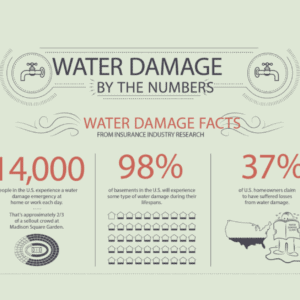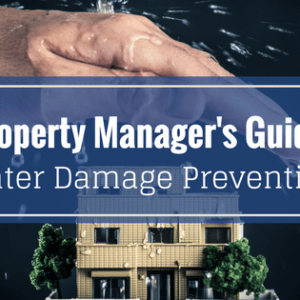Flood damage can come from many places in a rental property. An upstairs tenant accidentally leaves a sink on, and the downstairs tenant has a flood. A pipe bursts in a basement, rendering the apartment building’s laundry room unusable. Water damage advice and water restoration services are valuable for any property manager.
Here are some important things to keep in mind about water damage.
Know the Scope of the Problem
Flood damage can be insidious and pervasive:
- Mold and mildew growth: Left unrestored, water damage can lead quickly to debilitating mold and mildew, causing significant damage.
- Damage to building foundations: On a building’s exterior, clogged gutters or damaged downspouts can direct too much water back toward the foundation, requiring extensive water damage restoration to improve structural stability.
- Rooftop damage: Ponding water on flat roofs can cause water infiltration; moss on shingles can break down shingles’ water resistance.
- Damage within walls: Leaking pipes or inter-floor flooding can damage electrical lines, destroy drywall and rot wood structural members.
It is wise to ensure that all stakeholders — tenants, maintenance crew members and management staff — have an appreciation for the potential damage that water can cause and to report issues immediately when discovered.
Prevention
Accidents happen and not all water damage can be prevented, but a thoughtful prevention plan should include these three aspects:
- Tenant education: Provide information on recognizing signs of mold and mildew, keeping bathrooms and kitchens ventilated and dry and promptly informing property management if water damage is suspected.
- Careful maintenance: Your facilities crew should pay attention to areas likely to suffer the greatest water damage, such as roofs, internal pipes, basement areas around appliances and rooftop HVAC equipment.
- Cycle of inspections: While respecting tenants’ privacy, you can check individual kitchens and baths; common areas such as crawlspaces, attic areas and hallway walls; and exterior roofs, gutters and downspouts.
By emphasizing prevention over reaction, you can keep water damage restoration costs down while keeping your tenants happy.
Emergency Planning
Tenant education, careful maintenance and regular inspection can cut down on the risks, but having an emergency response plan can be invaluable. Such a plan should include:
- Documenting the damage: For insurance purposes and to protect your property, take pictures and document the extent of any damage; this is even more important if tenant property is of concern.
- Notifying and helping affected tenants: Go the extra mile to assist anyone on the property affected by the water damage; this will gain you goodwill and tenant cooperation.
- Contacting trained professionals: Have handy the contact information for a highly trained company such as Certified Restoration so we can get to work immediately.
Certified Restoration
For property managers in the San Diego, CA, area, professional, prompt flood damage restoration services are available from Certified Restoration. We have a comprehensive program of water damage restoration. We will begin work at your property promptly to stop the cause and start repairing the damage. Contact Certified Restoration today.



